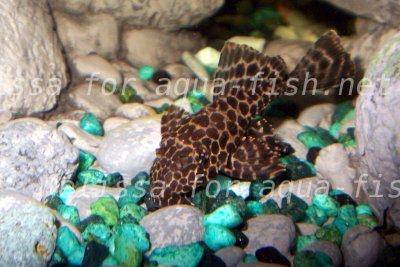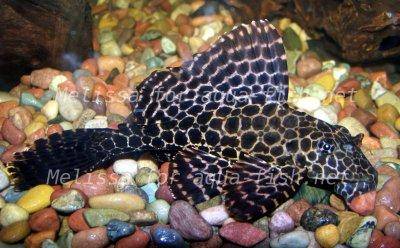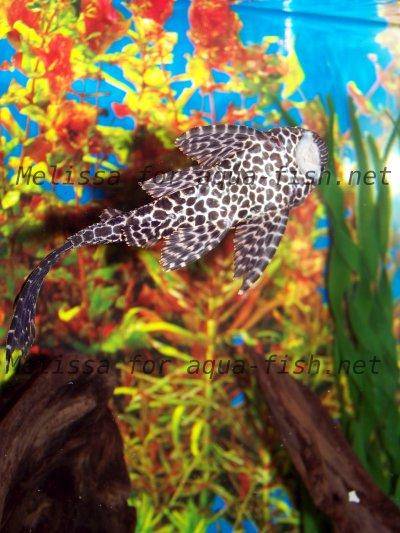Marble Pleco Care: Diet, Compatibility, and Tank Requirements
Quick links - Answers
Brief Description
This guide covers all aspects of raising Marble Plecos in aquariums, including tank setup, diet, and compatibility. We’ve included everything you need to know to keep your Marble Pleco healthy and thriving. If you have any further questions or want to share your experiences, feel free to engage in the comments section below.
The Glyptoperichthys gibbiceps, commonly known as the Marble Pleco, is a unique species of sucker fish. It's also referred to as the Sailfin pleco or Leopard pleco due to its distinctive appearance.
Diet and Feeding Habits
Marble Plecos are herbivores, requiring a diet rich in algae and vegetables. While they will graze on the algae that naturally grows in the tank, it’s essential to supplement their diet with algae wafers or pellets. Spirulina, a type of blue-green algae, is particularly beneficial for its nutritional value. For vegetable options, consider softening peas, spinach, lettuce, or cucumber by briefly boiling them. Although they can be conditioned to accept some meaty foods, the majority of their diet should be plant-based to ensure proper digestion. Additionally, Marble Plecos need a small amount of wood in their diet, as the cellulose found in wood aids in their digestion.
Water Conditions
Marble Plecos are quite adaptable when it comes to water conditions and can thrive in a variety of settings, making them excellent companions in community tanks. However, any adjustments to the water parameters should be done gradually to allow them time to acclimate. The ideal temperature for their tank is between 72 and 82°F (22 - 28°C), with a pH range of 6.5 to 7.5, making the water slightly acidic to slightly alkaline. Water hardness should range between 5dH and 20dH, with the optimal level around 12dH. The tank should be at least 4 feet (~122cm) long to accommodate a fully grown Marble Pleco. Always maintain clean, well-oxygenated water, and a slight current can mimic their natural habitat of slow to fast-moving waters.
Aquarium Setup and Décor
Fully grown Marble Plecos do not usually tolerate the presence of other plecos in the same tank. If you plan to keep more than one, it's crucial to provide ample hiding spots and separate territories for each fish. Caves made from logs or rocks work well for these retreats. The substrate should consist of smooth gravel, allowing the pleco to maintain suction as it feeds on algae at the bottom of the tank. Flat, broad-leafed plants are ideal for grazing when they’re young, and while they generally prefer algae to plants, ensuring they are well-fed can prevent them from nibbling on live plants. If plant-eating becomes an issue, switching to artificial plants is a good solution. Incorporating wood into the tank setup is essential, as it supports the pleco’s digestive health.
Natural Habitat
The Marble Pleco (Glyptoperichthys gibbiceps) is native to South America, primarily inhabiting the Orinoco and Amazon River Basins.
Appearance
The G. gibbiceps is a striking fish that stands out in any aquarium. Its body is covered in a dark black to rich chocolate color, adorned with cream-colored circular patterns, giving it the distinctive “Marble” or “Leopard” pleco nickname. One of its most eye-catching features is the tall dorsal fin, which, when fully extended, resembles a sail. The large caudal fin, combined with the extended dorsal fin, gives this species a powerful and imposing presence in the tank. The pleco’s flat underside allows it to rest comfortably on the aquarium floor, while its round, suction-like mouth is perfectly designed for grazing on algae-covered surfaces. Though slow-growing, this species can eventually reach an impressive 19 inches (~48cm) in length, making it unsuitable for smaller tanks.
Defense Adaptations
The Marble Pleco has evolved unique defenses to protect itself from predators. Its pectoral and dorsal fins can lock in place, making it difficult for predators to swallow them. Additionally, their tough, scaly skin offers extra protection, making it challenging for larger predators to bite, grind, or digest them.
Longevity
The average lifespan of a Marble Pleco is around 15 years. However, with excellent care and optimal conditions, they may live even longer, making them a long-term commitment for any aquarium owner.
Gender Differences
Visually, it can be difficult to distinguish between male and female Marble Plecos, as their appearances are quite similar. Females may appear slightly larger and rounder, but this is not a reliable method for sexing. Experienced aquarists may be able to identify males and females by examining their genitalia.
Breeding
Breeding Marble Plecos in home aquariums can be quite challenging. In their natural habitat, these fish dig large pits or caves along riverbanks to deposit their eggs. The male takes on the role of protector, guarding the eggs and fry until they are ready to fend for themselves. Professional breeders in regions such as Asia, the United States, and Australia often use specially designed breeding ponds with earthen walls to replicate the ideal conditions for spawning. These environments closely mimic the wild, encouraging successful reproduction of these majestic plecos.
Tank Compatibility
The Glyptoperichthys gibbiceps is a peaceful species that can coexist with most fish, from smaller, delicate species to larger, moderately aggressive ones. However, it’s important to avoid housing them with other Marble Plecos or similar species, as they tend to be territorial with each other. While they may display aggression towards one another, their confrontations are generally mild, involving head-bumping rather than any serious harm. To reduce stress and potential conflicts, it's best to limit one Marble Pleco per tank.





